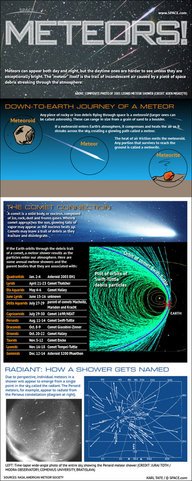
The peak of the Perseid Meteor Shower is coming in just a few days! According to NASA meteor expert Bill Cooke, the Perseids are perhaps the most popular meteor shower of the year. Typical rates are about 80 meteors an hour, but in outburst years (such as in 2016) the rate can be between 150-200 meteors an hour. The meteor shower's actual peak is around 1 p.m. EDT Aug. 12, which means that the night before and the night after will both have good rates; Cooke said the show would be slightly better in the predawn hours of Aug. 12, but that there'd be a decent show both nights.

In 2017, the Perseids will be a little more difficult to see due to the presence of the moon, which will be three-quarters full and will rise shortly before the shower hits its peak around midnight local time.
"Rates will be about half what they would be normally, because of the bright moonlight," Cooke told Space.com. "Instead of 80 to 100, [there will be] 40 to 50 per hour. And that's just because the moon's going to wash out the fainter ones."
"But the good news is that the Perseids are rich in fireballs; otherwise the moon would really mess with them," Cooke added.

When to see them?
Earth will pass through the path of Comet Swift-Tuttle from July 17 to Aug. 24, with the shower's peak — when Earth passes through the densest, dustiest area — occurring on Aug. 12. That means you'll see the most meteors in the shortest amount of time near that peak, but you can still catch some action from the famed meteor shower before or after that point.
**
The 2017 Perseid meteor shower will peak around 1 p.m. EDT (1700 GMT) on Aug. 12, so the nights of Aug. 11-12 and Aug. 12-13 should see the highest rates. The meteors appear to radiate out of the constellation Perseus, from which they take their name.
Credit: NASA/JPL-Caltech**
The moon will be three-quarters full during the peak. Since the moon will rise late in the evening (around roughly 11 p.m.), there will be some interference from its light that will make it more difficult to see meteors.
You can see the Perseid meteor shower best in the Northern Hemisphere and down to the mid-southern latitudes, and all you need to catch the show is darkness, somewhere comfortable to sit and a bit of patience.
The moon will be three-quarters full during the peak. Since the moon will rise late in the evening (around roughly 11 p.m.), there will be some interference from its light that will make it more difficult to see meteors.
@source
What causes the Perseids?
Comet Swift-Tuttle is the largest object known to repeatedly pass by Earth; its nucleus is about 16 miles (26 kilometers) wide. It last passed nearby Earth during its orbit around the sun in 1992, and the next time will be in 2126. But it won't be forgotten in the meantime, because Earth passes through the dust and debris it leaves behind every year, creating the annual Perseid meteor shower.
When you sit back to watch a meteor shower, you're actually seeing the pieces of comet debris heat up as they enter the atmosphere and burn up in a bright burst of light, streaking a vivid path across the sky as they travel at 37 miles (59 km) per second. When they're in space, the pieces of debris are called "meteoroids," but when they reach Earth's atmosphere, they're designated as "meteors." If a piece makes it all the way down to Earth without burning up, it graduates to "meteorite." Most of the meteors in the Perseids are much too small for that; they're about the size of a grain of sand.
What do you need to see them?
The key to seeing a meteor shower is "to take in as much sky as possible," Cooke said. Go to a dark area, in the suburbs or countryside, and prepare to sit outside for a few hours. It takes about 30 minutes for your eyes to adjust to the dark, and the longer you wait outside, the more you'll see. A rate of 150 meteors per hour, for instance, means two to three meteors per minute, including faint streaks along with bright, fireball-generating ones.
Some skywatchers plan to camp out to see the Perseid meteor shower, but at the very least, viewers should bring something comfortable to sit on, some snacks and some bug spray. Then, just relax and look upward for the celestial show.
@source
Thank You @sujoy1995

Hi! I am a robot. I just upvoted you! I found similar content that readers might be interested in:
https://www.space.com/32868-perseid-meteor-shower-guide.html